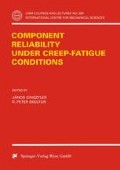Abstract
Pointing at the importance of material selection in design process, the responses of structural materials to loading are discussed. The response can be an elastic or a plastic deformation or the material can fracture. These physical processes are discussed briefly examining them in atomic scale as well as in microscopic and in macroscopic sense. The influence of loading conditions as e.g. temperature or alternating loading are discuss too. The damage processes due to the loading are also shown.
The usual testing methods are overviewed and the different material characteristics are criticised. It is shown that although the testing methods are simple models of the real loading conditions, the most material parameters are not well defined indicators and therefore their misuse can result serious mistakes. Difficulties in fatigue and creep testings are exposed.
Access this chapter
Tax calculation will be finalised at checkout
Purchases are for personal use only
Preview
Unable to display preview. Download preview PDF.
References
Czoboly, E. (1995) I,iIn:iMechanical behaviour of materials at high temperature. Ed.:C. Moura Branco, R.Ritchie and V.Sklenicka. NATO ASI Series. Kluwer Academic Publisher. Dordrecht /Boston/London. 3–22.
Courtney, Th. H. (1990) IMcGrow-Hill Publishing Company. New York, USA
Schaft, W. (1972) IDeutscher Verlag für Grundstoffindustrie. Leipzig, Germany
Finnie, I. and Heller, W.R. (1959) IMcGraw-Hill Company, Inc. New York/Toronto/London.
Irwin, G.R. (1958) IContr. to the First Symp. on Naval Struct. Mechanics. Stanford University, Stanford, USA.
Griffith, A.A. (1920) IPhil. Trans.Roy. Soc. London, A-221, 163–179.
Berkovic, M., Sedmak, A. and Janie, J. (1990) IProc. 5th Int. Fracture Mechanics Summer School. EMAS, Warley, U.K. 71–88
Ginsztler, J. (1989) IIn: Low Cycle Fatigue and Elasto-Plastic Behaviour of Materials. Ed.: K.T.Rie. Elsevier Applied Science, London 643–648.
Gillemot, L. (1963) IFreiberger Forschungshefte September, 5–13.
Gillemot, L. (1963) ISchweisstechnik 13.1–1.7. 305–312.
Czoboly, E., Havas, I. and Gillemot, F. (1982) I,iProc. Int. Symp.on Absorbed Specific Energy and/or Strain Energy Density Criterion Akadémiai Kiadó, Budapest, Hungary 3, 330–336.
Radon, J.C., Czoboly, E. (1972) IProc. Int. Conf. on Mechanical Behaviour of Materials, Kyoto, Japan, 543–557.
Havas, I., Schulze, H.D., Hagedorn, K.E. and Kochendörfer, A. (1974) IMaterialprüfung 16. Nr. 11. 349–353.
Czoboly, E. et al. (1989) IProc. ICF7. Advances in Fracture Research. Pergamon Press, New York, USA, 3555–3562.
Dauskardt, R.H. and Ritchie, R.O. (1993) IAdvanced Materials & Processes, July, 26–31.
Gell, M. and Leverant, R. (1973) IIn: Fatigue at Elevated Temperatures. Ed.: A. E. Carden, A. J. McEvily and C. H. Wells. ASTM Publication 520. Philadelphia, PA, USA. 37–66.
Benham, P.P. (1958) IMetallurgical Reviews 3.No.11. 203–234.
Miller, K.J. and de los Rios, E.R. (1986) IEuropean Group on Fracture Publication 1. MEP Institution of Mechanical Engineers, London, UK.
Neuber, H. (1961) ITrans ASME, Series E., 83
Czoboly, E., Havas, I. and Ginsztler, J. (1984) IProc. 5th EGF. Lisbon, Portugal, EMAS, Warley, U.K. 481–494.
Czoboly, E. and Sandor, B.I. (1974) IEES Report No 39. University of Wisconsin, USA 1–236.
Broek, D. (1978) ISijthoff and Noordhoff, Alphen aan den Rijn, The Netherlands.
Paris, P.C. and Erdogan, F. (1963) IJ. Basic Eng. Trans ASME Series D. 85. 528–534.
Tóth, L. (1994) IIn: Handbook of Fatigue Crack, Ed.: A.Carpinteri. Elsevier, Amsterdam 1643–1683.
Miller, K.J.(1991) I,iProc. of Institution of Mechanical Engineers, 205 1–14.
Radon, J.C. and Czoboly, E. (1988) IPeriodica Polytechnica 32. No. 2. 107–117.
Radon, J.C. (1990) IProc. 5th Int. Fracture Mechanics Summer School. EMAS, Warley, U.K. 117–134.
Webster, G.A. (1996) IIn: Mechanical behaviour of materials at high temperature. Ed.:C. Moura Branco, R.Ritchie and V.Sklenicka. NATO ASI Series. Kluwer Academic Publisher. Dordrecht /Boston/London. 169–193
Saxena, A. et al. (1990) IIn:iElevated Temperature Crack Growth.Eds.: S.Mall and T.Nicholas.ASME Book No G00530.
Hollstein, T. and Kienzler, R. (1990) IProc. 5th Int. Fracture Mechanics Summer School. EMAS, Warley, U.K. 175–188.
Lukas, P., Kunz, L. and Sklenicka, V. (1996) IIn: Mechanical behaviour of materials at high temperature. Ed.:C. Moura Branco, R.Ritchie and V.Sklenicka. NATO ASI Series. Kluwer Academic Publisher. Dordrecht /Boston/London. 155–167.
Author information
Authors and Affiliations
Editor information
Editors and Affiliations
Rights and permissions
Copyright information
© 1998 Springer-Verlag Wien
About this paper
Cite this paper
Czoboly, E. (1998). Basic Mechanisms of Creep and the Testing Methods. In: Ginsztler, J., Skelton, R.P. (eds) Component Reliability under Creep-Fatigue Conditions. International Centre for Mechanical Sciences, vol 389. Springer, Vienna. https://doi.org/10.1007/978-3-7091-2516-8_3
Download citation
DOI: https://doi.org/10.1007/978-3-7091-2516-8_3
Publisher Name: Springer, Vienna
Print ISBN: 978-3-211-82914-1
Online ISBN: 978-3-7091-2516-8
eBook Packages: Springer Book Archive

